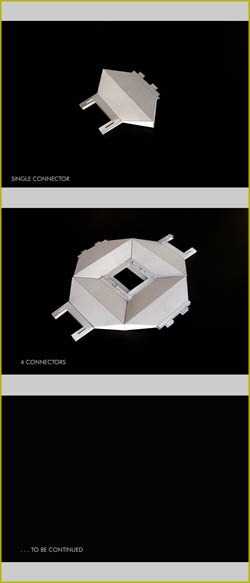
Tate in Space Model, David
Rickard © 2003
|
Through advances in technology we have acquired a certain
familiarity with space, space travel and even the idea of space
holidays or residency. Yet it remains that only a handful of people
have physically experienced space. Except for these few astronauts
our understanding of space has been built entirely from mediated
experiences (television, cinema, internet, printed material etc).
During the first years of ‘Tate in Space’ it will undoubtedly
remain that the number of physical visitors will be very few in
comparison to those who will continue to experience space through
media. During this initial stage the gallery will exist predominantly
as a distant, translated object. Without the demands of human habitation
the gallery could begin with just one artwork suspended in space.
To allow expansion of the gallery connectors need
be fitted to the first artwork. The art works need not be standard
in shape nor form just as long as the connectors can be attached
at some location. No longer is the gallery housing the art product
but rather within this new context the architecture simply forms
a connection between the works to stop them from drifting apart.
As time and resources permit the gallery can expand to accommodate
new artworks and even physical visitors. During it’s expansion
‘Tate in Space’ will slowly evolve from a small cluster
into a flowing skin. Through very slight changes in the angle between
each folded connector this skin may eventually enclose an organic
volume. It will be a large evolving space, without up or down, made
from a surface of connected art works.
|



